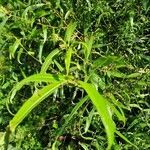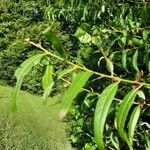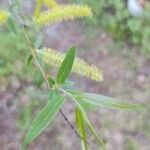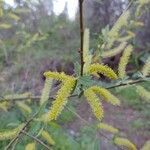Trees, 5-10 m. Stems: branches ± brittle at base, gray-brown to red-brown, glabrous, villous, or tomentose; branchlets yellow-brown to red-brown, glabrous, sparsely or densely villous or tomentose. Leaves: stipules rudimentary or foliaceous on early ones, foliaceous on late ones, apex convex to acute; petiole (with spherical glands distally), (3-)4.5-14(-22) mm, tomentose or pilose adaxially; largest medial blade lorate or lanceolate to narrowly lanceolate, (50-)75-115(-220) × 10-22(-35) mm, 5-10 times as long as wide, base usually convex or cuneate, sometimes rounded to cordate, margins serrate or serrulate, apex acuminate, acute, or caudate, abaxial surface glabrous or sparsely tomentose on midribs, hairs white and/or ferruginous, wavy, adaxial highly glossy, glabrous or pilose, hairs white and/or ferruginous; proximal blade margins entire or serrulate; juvenile blade glabrous, or moderately densely tomentose or silky abaxially, hairs white and ferruginous. Catkins: staminate 28-97 × 5-11 mm, flowering branchlet 4-25 mm; pistillate 33-93 × 7-15 mm, flowering branchlet 3-35 mm; floral bract 1-3 mm, apex acute or rounded, entire or erose, abaxially sparsely hairy, hairs wavy; pistillate bract deciduous after flowering. Staminate flowers: abaxial nectary 0.3-0.5 mm, adaxial nectary oblong to narrowly oblong, 0.3-0.6 mm, nectaries distinct; stamens 4-7; filaments (sometimes connate less than 1/2 their lengths), hairy basally; anthers 0.4-0.6 mm. Pistillate flowers: adaxial nectary oblong, square, or ovate, 0.3-0.7 mm; stipe 1.3-5.3 mm; ovary pyriform to obclavate, beak slightly bulged below styles; ovules 12-16 per ovary; styles (sometimes distinct distally), 0.1-0.2 mm; stigmas 0.16-0.2-0.28 mm. Capsules 4-6 mm.
More
Shrub or tree to 10 m, or larger westward; buds conic, sharp-tipped, the short (3–7 mm) scale with free, overlapping margins; petioles and twigs yellowish to dark brown, usually white-hairy the first year, the petiole with glandular dots or processes at the summit; stipules well developed and persistent, 7–15 mm, broadly reniform, serrulate; lvs spreading, lance-linear to lanceolate (or the young ones often oblanceolate and obtuse), 7–15 × 0.7–3 cm, mostly 5–10 times as long as wide, long-acuminate, closely serrulate, dark green or yellowish-green above, densely glaucous beneath, often hairy, especially along the midrib, the areoles minute beneath; catkins with the lvs, 3–11 cm, on lax, leafy peduncles 2–5(–7) cm; scales yellowish, villous, deciduous; stamens (4–)6(–8); fr narrowly lance-ovate, 3–6 mm, granular-roughened; pedicels 1.5–5 mm; style 0.1–0.2 mm. Floodplains and other moist or wet low places; Del., Md., and the Potomac and Ohio valleys (to Pittsburgh and s. Ind.), w. to e. Kans. and Okla., s. to Cuba and Guat. (S. ambigua; S. longipes; S. wardii)
Alluvial woods on floodplains, swamps, hummocks, marshes, wet interdunal depressions, rocky or gravelly streambeds, ditches, canals, usually on calcareous substrates; at elevations up to 600 metres





